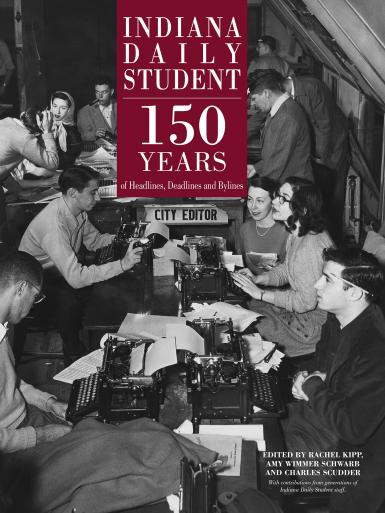Alumni-produced anthology chronicles IDS history
There’s the time Kathryn Flynn, BA’87, used a Nick’s English Hut menu as a straightedge to design the front page of the Indiana Daily Student after the IU men’s basketball 1987 NCAA Championship.
There’s the time the IDS reviewed the newly released “Breaking Away,” deeming it “superficial” and “trivial.”

The time the IDS started charging for the paper. The time the publication went online. The time the print publications cut back to two days a week.
And all the times it covered campus- and world-changing news, from the end of World War I, to the selection of Herman B Wells as IU’s president, to the first Little 500 and the terrorist attacks of Sept. 11, 2001.
“Indiana Daily Student: 150 Years of Headlines, Deadlines and Bylines” chronicles all those times and more. The 288-page, alumni-produced anthology features historic front pages, photographs, archived articles and alumni reflections in celebration of the publication’s 150th anniversary in 2017 and IU’s 2020 Bicentennial.
The book, published by IU Press, is available for preorder now and will be released Oct. 1.
Editors Amy Wimmer Schwarb, BAJ’96; Rachel Kipp, BAJ’02; and Charlie Scudder, BAJ’14, of the IU Student Publications Alumni Association spearheaded the project, which was funded by a $12,000 IU Bicentennial grant.
Schwarb, Kipp and Scudder started by creating a shared spreadsheet that split the work into IDS eras, which were assigned to the three editors.
“The process was tedious,” Scudder said. “A lot of time was dedicated into reaching out to alumni to see if they wanted to contribute, but we focused more on being editors.”
The editors commissioned articles from dozens of alumni contributors and scoured archives dating back to the 1800s. Kipp credited Marge Blewett, BA’48, for the extent of the available archive. Blewett, who worked as a lecturer and placement director in the School of Journalism, died in February.
“She (was) an amazing person. Without her the project couldn’t have come together,” Kipp said. “It was decades and decades of work preserving these documents and fact-checking. Her notes were noted on the edges of the margins.”
Though the three editors lived in different regions, Schwarb — who lives in Indianapolis — worked directly with the IU Archives to access microfilm and correspondence between editors. She noted that finding some of the historical front pages was a challenge due to a lack of a digital archive.
Three interns — Jamie Zega, BAJ’18; Laresa Lunda, BA’18; and junior Matt Rasnic — contributed to the project by managing timelines and deadlines, scanning documents and designing the cover.
Featured articles include “It’s in the Air,” a column published by Ernie Pyle in 1922 about the beauty of IU’s campus and students’ love for the school. Alumni reflections include memories of moving into Ernie Pyle Hall, moving out of Ernie Pyle Hall and covering Bob Knight’s Hoosiers.
While the book shares many heartwarming memories, it was important to the editors to portray the IDS experience accurately. Schwarb said it would have been easy to let nostalgia overpower authenticity.
“The truth is that the IDS has always been really hard work and it still is now, and that’s why people are drawn to it,” Schwarb said. “The work is important, but it’s really difficult to pull off as a student.”
Through this project, Schwarb, Kipp and Scudder learned that all IDS editors – themselves included – faced many of the same struggles.
“You find out that these problems are universal,” Kipp said.
Scudder said that digging into the IDS’s history and seeing how it responded to challenges taught him about the ultimate strength needed to continue to publish the paper.
“We learned a lot about the history and legacy of the institution on campus and how it covered not only the Bloomington community, but state and national news,” he said.
By telling the history of the IDS, the book tells the history of IU. The IDS is one of the oldest entities on campus, and it has recorded the student perspective of campus news since its beginning. Scudder said he thinks anyone with IU ties can appreciate the book — not just IDS alumni.
“This is the kind of book that will attract those interested in student journalism, but it has something for everybody,” Scudder said. “It has something for everybody to care about.”

